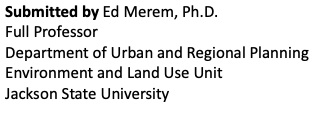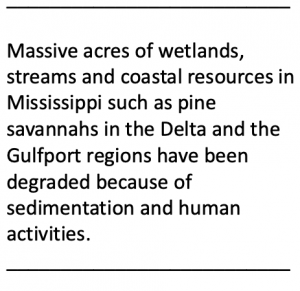
[hr]The Department of Urban and Regional Planning (DURP) in the College of Science Engineering and Technology and its research partners have produced findings related to environmental change, renewable energy (geothermal), water resources, land resource management and food security in the U.S. and sub-Saharan Africa.

Core research show that the western region of the U.S. faces increased water depletion as major aquifers decline at a much faster rate than expected due to socio-economic, environmental and physical factors.
Recently, water sources such as Lake Mead and the Colorado River dropped to their lowest levels due to hydrological stress in a region known for its water-intense agriculture and demands from surrounding large cities. Water is running low for urban dwellers and farmers. As well, the Lower sub-basin also risks drying up from impending climate change that has reduced the river’s tidal movement from 10 percent to 30 percent.
Devastation of natural habitats
Notwithstanding ongoing restoration statewide, natural habitats in Mississippi still face widespread devastation.
In fact, massive acres of wetlands, streams and coastal resources such as pine savannahs in the Delta and the Gulfport region have been degraded because of sedimentation and human activities.
Bearing in mind that the most significant threats to biodiversity now involves the fragmentation of animal and plant habitats, wildlife habitat conservation has assumed far more significance than ever.
To that effect, the assessment of wildland use in Mississippi points to gains and declines in the Conservation Reserve Program (CRP) land areas with the central and northeast region outpacing the southwest zones of the state coupled with degradation.
In addition, the spatial analysis of the trends also pinpointed the concentration of vast natural areas statewide.
Elsewhere, in West Africa, the tragedy of illegal fishing by foreign trawlers along the coastal areas of the region is prompting the extinction of local fish species at a scale that threatens community livelihoods from Senegal to Nigeria.
 With the region facing the highest levels of “illegal, unreported and unregulated” (IUU) fishing activities, the plunder by overseas trawlers for decades accelerated the overfishing of more than 50 percent of fish stocks.
With the region facing the highest levels of “illegal, unreported and unregulated” (IUU) fishing activities, the plunder by overseas trawlers for decades accelerated the overfishing of more than 50 percent of fish stocks.
The dilemma is compounded by the 250 species of fish reported taken from coastal waters of the region from 1950 to 2009 and the fact that around 40 percent of all fish caught in West African waters ended in the hands of IUU operators from abroad.
Accordingly, the economic costs of IUU since 1980 stands at $137.9 billion in liabilities for West Africa.
On the dangers posed by climate change hazards in the Southern coastal zone of Nigeria, various scenarios show that parts of the global city of Lagos responsible for 60 percent of the nation’s GDP and the oil hub of Port Harcourt in the Niger Delta will likely be submerged in 2100, especially with the pace of changing climatic parameters such as sea level rise, increased temperature and greenhouse gas emissions).
GIS and remote sensing mapping of land use trends in the eastern part of the country reveal notable deficits for bush land, grass land and water areas from 2000-2017. Added to that, gullies and areas exposed to erosion amounts to $100 million annually in damages, including the destruction of lives and properties in many localities.
In all these years, the total area impacted by rill, sheet or gully erosion in the zone rose by 1.33 percent (1,021 km2) in 1976 to 3.7 percent (2,820 km2) in 2006.
Role of geothermal energy
In the area of renewables, the growing level in capacity and access among users in the Rift Valley area has unlocked the potentials of Kenya as the new frontier of geothermal power in East Africa. The emergent role of geothermal energy in the cities is being felt with reduced tariffs and the move away from conventional sources such as hydro power due to irregular rainfall patterns and drought.
The merits of the U.S. research on the western region and Mississippi stand on its own. Similarly, the implications of the West African portion show that ecology and natural resources therein (past and present) are central to the lives of its citizens. It is also vital in understanding current discourses shaping African-American imagination and its environmental history.
 Therefore, the plunder of fish stocks by foreign trawlers this time around should concern us, considering that the dreaded crossing of the Atlantic during the slave trade era occurred off the same coast of West Africa centuries ago. Now, this area is at the epicenter of another matter in which local communities face resource dispossession. This time, however, it’s under a different guise by illegal fishers from the EU and the Far East.
Therefore, the plunder of fish stocks by foreign trawlers this time around should concern us, considering that the dreaded crossing of the Atlantic during the slave trade era occurred off the same coast of West Africa centuries ago. Now, this area is at the epicenter of another matter in which local communities face resource dispossession. This time, however, it’s under a different guise by illegal fishers from the EU and the Far East.
This development begs the question: Why the West African coast again? Just think about it in the context of black environmental history in minority communities and planning.
Realizing that up-to-date knowledge of ecological resource inventory is crucial to efficient planning, lack of regular access to these findings can result in faulty mitigation measures at the expense of public welfare.
The expectation is that the outcome of these studies will sharpen the capacity of managers in ensuring sustainable use of natural resources. The research will also produce a better understanding of human-nature interface that is central to climate change adaptation and the design of resilient cities.
__________________________
(This collaborative work involved JSU researchers and students led by Dr. Edmund Merem, Dr. Yaw Twumasi and Dr. Joan Wesley. Academic areas included JSU’s College of Public Health; and JSU’s Department of Public Policy and Administration in the College of Liberal Arts. Expertise also was provided by the Department of Urban Forestry and Natural Resources at Southern University A&M in Baton Rouge, Louisiana.)






